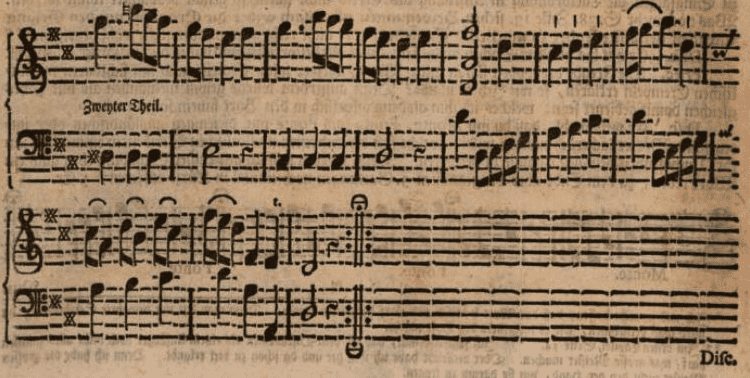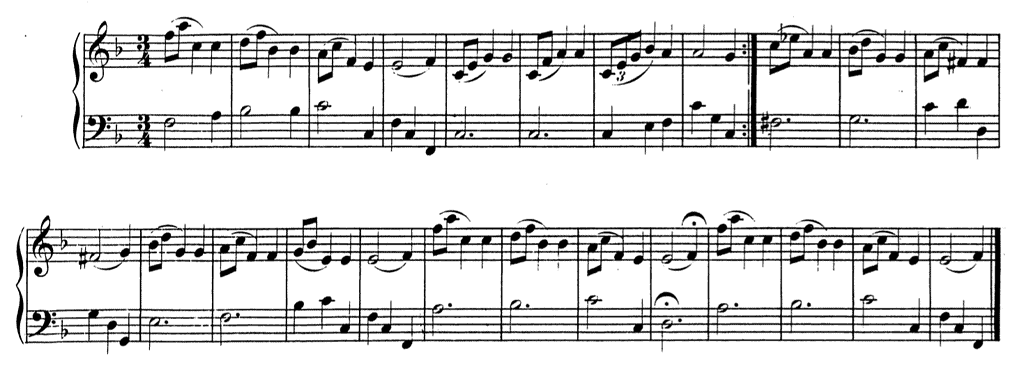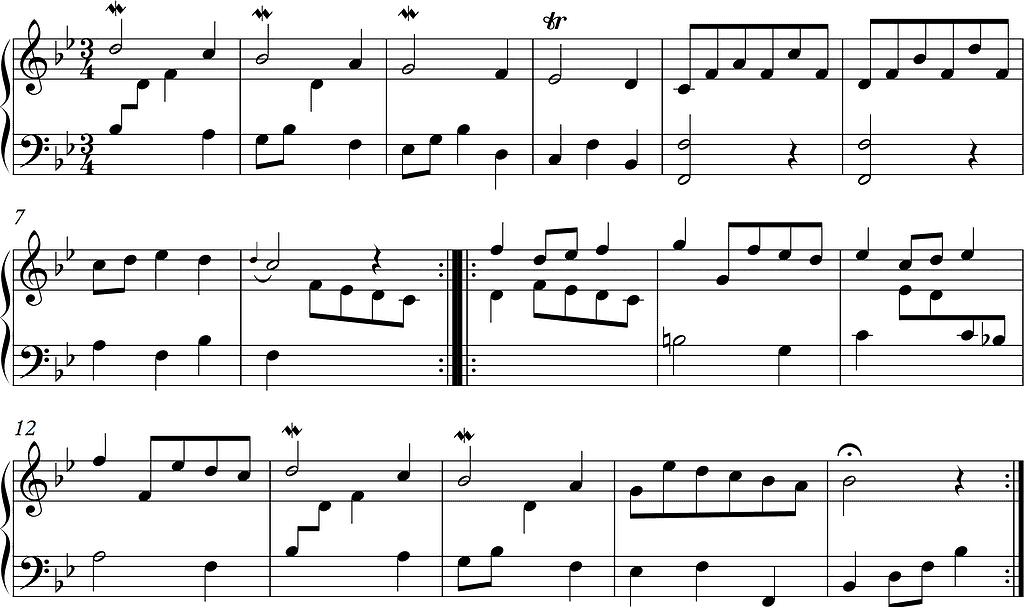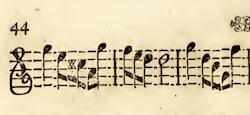The Fonte is a widely used schema in the 17th and 18th centuries and exists in many variants. In this essay, I will focus on the schema’s characteristics.
The Fonte is essentially a descending sequential pattern with 2 segments, each segment constituting a ⑦–① cadence with a ➍–➌ melody. Segment 1 is written in the minor key of the supertonic, segment 2 in the main major key. A Fonte regularly opens the second half of a (rounded) binary form.
This essay will deal with the following types of Fontes:
The Fonte With a ⑦–(⑤–)① Bass Line in Both Segments
The Fonte With a ⑤–(⑦–)① Bass Line in Both Segments
The Fonte With a (⑤–)④–③ Bass Line in Both Segments
The Chromatic Fonte
The Fonte With the Hermaphrodite Note
The Fonte With a Metric Shift
The Fonte With a Metric Shift and the Hermaphrodite Note
Term and Interpretation
The term and interpretation of the Fonte (Italian for well) comes from Joseph Riepel (1709–1782), chapel master in Regensburg. He describes the Fonte as a pattern that is often used as the opening gesture of the second half of a binary form in a major key. Riepel defines the Fonte as having two segments that are each other’s transpositions. The first segment is written in the minor key of the supertonic (e.g. D minor when the main key of the piece is C major), the second segment in the main major key, one step lower.
Q&A MOMENT
Can a Fonte Occur in a Minor Key?
A Fonte in relation to a minor key does not exist since the triad on ② is diminished and therefore cannot act as a tonic triad. (A Fonte, however, can occur in a section in a major key within a piece set in a minor key. In this case, the Fonte usually relates to the relative (major) key. I will explain this type of Fonte in my essay The Fonte in Other Keys.)
Most of the examples Riepel gives in his treatises contain only the melody. Still, he gives enough examples and explanations to make their harmonic situation unambiguous. Consider the following example, which shows the beginning of the second half of what seems to be a minuet (bars 9–16).

(Note that the first note of bar 11 (bar 3 in the example) should be an F instead of a G.)
The key of bars 9–10 (bars 1 and 2 in the example) is D minor, that of bars 11–12 (and of the four-bar conclusion of this sixteen-bar piece) is C major.
Have a look now at the following example, showing the melody of a complete minuet.

(Note that Riepel uses a black square to indicate what he calls a Grundsatz, i.e., a sentence ending on ①.)
This minuet starts in the key of C major (bars 1–4). After this four-bar phrase, the music leaves C major for G major (bars 5–8). After the double barline, one can recognize the same four-bar pattern as the one in the previous example. (Riepel actually marks “Fonte” at this point.) Notwithstanding the absence of the C♯ in bar 9, it is obvious that the implied key of bars 9–10 is D minor. This two-bar fragment is again transposed one tone down to C major (bars 11–12).
I will show now how to add one possible bass to this melody.
The Fonte With a ⑦–① Bass Line in Both Segments
A much-used bass progression for the local ➍–➌ melodies of the Fonte is a local ⑦–① snippet, putting ⑦ below ➍ and ① below ➌. That way, each segment of the Fonte is a ⑦–① cadence or clausula cantizans.
In the third volume of his Anfangsgründe (1757), Riepel gives a minuet with a bass part —in D major instead of C major— that includes a nearly identical Fonte melody to the one above. The example below shows the start of the minuet’s second half, opening with a Fonte:

In the next example, I have transposed this Fonte a step down to be able to compare it more easily with Riepel’s example without bass:

Gjerdingen points out that “the ⑦–① ascent in the bass is matched by a ➍–➌ descent in the melody, often terminating a larger ➏–➎–➍–➌ descent that the Fonte shares with the Prinner” (Gjerdingen, 2007: 62). (However, I am less inclined to see this ➏–➎–➍–➌ descent as a feature that is shared with the Prinner. When this descent is used in the context of a Prinner, each of those scale steps functions as a structural/essential note of the pattern. In the context of the Fonte, however, the presence of the first three notes of the ➏–➎–➍–➌ descent is optional/ornamental/unessential.)
Tip
The easiest, fastest method of realizing the first chord of this type of Fonte at the keyboard is to first determine ① and ➎ (of the main key), and then raise ① chromatically.
With a ➎–➍–➌ Melody in Both Segments
One can also opt to write or play a local ➎–➍ melodic snippet on each ⑦:

The second chord of each segment can be set with a 4–3 and/or a 9–8 suspension:

With ⑦ in Both Segments Set With ➏(♭)
Each ⑦ can also be set as a seventh chord:

Gjerdingen calls this type of clausula cantizans a Jommelli, in honour of Niccolò Jommelli (1714–1774), “who was among the most brilliant products of the Neapolitan conservatories” (Gjerdingen, 2007: 159).
Note that, when respecting the respective keys/scales, the seventh chord in D minor is diminished, the one in C major half-diminished. Composers, however, sometimes preferred to have a diminished seventh chord in the second segment as well. (In the example above, this would result in the presence of an A♭ in bar 3, a note that is obviously foreign to the scale of C major. Make sure to play this version as well.) That way, a beautiful chromatic melody emerges. (Yet not every 18th-century musician approved of this licence. I will come back to this below.)
After the double barline of the next example, a Fonte occurs in which each ⑦ is set as a seventh chord; the seventh chord on F♯ is diminished, the one on E half-diminished. Mozart wrote this minuet in January 1762, when he was about to turn six.

(Note how Mozart has doubled the length of each segment by having each ⑦–① cadence (bars 9–10 and 13–14) followed by a ⑤–① cadence (bars 11–12 and 15–16). I will come back at the use of a ⑤–① cadence in the context of a Fonte below and I elaborate on this minuet and the expanded Fonte in my essay The Fonte: Ars Combinatoria).
With ⑤ Inserted in Between ⑦ and ①
⑦ does not always move directly to ①; a small deviation via ⑤ is not uncommon.

(only strings, alto omitted)
The example above contains a Fonte with such a ⑦–⑤–① bass line. It is an excerpt from the motet Cœli voces Domenico Cimarosa (1749–1801) wrote in 1767 as a student at the Loreto Conservatory. The motet’s alto aria Avis nascente aurora is written in the key of F major.
Note how this example is metrically deviating from the indicated time signature. Due to the presence of each ⑤, which has the same length (a half note) as ⑦ and ①, one perceives a new, 3/2 time signature. Indeed, each segment of this Fonte lasts six instead four quarter notes. (I have marked both segments in this temporary 3/2 time signature with brackets.)
The Fonte With a (⑤–)④–③ Bass Line in Both Segments
Since both characteristic voices of the Fonte are written in invertible counterpoint, their relative position can be swapped. That way, each segment acts as a ④–③ cadence (or clausula altizans or what Gjerdingen calls a Passo Indietro (Gjerdingen, 2007: 167)):

In his book Music in the Galant Style, Gjerdingen gives a beautiful example of this type of Fonte from a trio sonata by Christoph Willibald Gluck (1714–1787) (Gjerdingen, 2007: 68; Gjerdingen omits the second violin). (Gluck was a German composer, today best know his operas, most particularly Orfeo ed Euridice (1762).)

Note that the bass in the second segment (bar 10) does not open with C but with C♭, the chromatically lowered sixth scale step of E flat major that the second violin takes over a quarter note later. I will elaborate on this chromatic alteration below.
The Fonte With a ⑤–① Bass Line in Both Segments
Another type of Fonte presents one or both of the characteristic voices in the upper voice(s) while the bass engages in a ⑤–① cadence. Have another look at the early minuet in F major KV2 of Mozart. While each segment of the Fonte opens with a clausula cantizans, it is followed by another type of cadence, a ⑤–① cadence with a ➐–➊ melody:

With ⑦ Inserted in Between ⑤ and ①
Just as ⑤ can be inserted in between ⑦ and ①, so can ⑦ be inserted in between ⑤ and ①. Whereas the latter insertion slightly strengthens a clausula cantizans, the insertion of ⑦ in between ⑤ and ① weakens a ⑤–① cadence.

A Fonte with a ⑤–⑦–① bass line occurs in the aria Per questo dolce amplesso by Johann Adolf Hasse (1699–1783). (Hasse had mastered his art in Naples with Alessandro Scarlatti before becoming one of the most celebrated composers of his time.)
The Fonte With Chromatic Alterations
Two variants of the Fonte are characterized by one specific chromatic alteration in the melody.
The Chromatic Fonte
While the first segment focuses on the minor key of the supertonic, it can conclude with a major third (also known as a Picardy Third). That way, both segments constitute a melody that descends half a step. And the interval between the melodic snippet of each segment is half a step as well, so that the complete Fonte melody constitutes a descending chromatic minor third.
The following example, a fragment from a theme and variations in B flat major by Dittersdorf, presents a chromatic Fonte after the double barline.

(violin 2 and viola are omitted; chromatic Fonte: bars 9–12)
(Note the Prinner with a nod to an embedded Fonte in bars 5–7a; for more information on this variant of the Prinner see my essay Variants of the Prinner (Part 3).)
The Fonte With The Hermaphrodite Note
We saw above how each ⑦–① bass snippet of the Fonte is often set with a ➍–➏–➎–➍–➌ melody. Here is once more Riepel’s example to illustrate this typical melodical gesture of the Fonte:

Sometimes, however, the ➍–➏–➎–➍–➌ melody of a Fonte’s first segment is literally transposed to the second segment, creating a chromatically lowered sixth scale step —➏♭— in the main (major) key:

However, this type of Fonte doesn’t please Riepel, who calls it “a wrong hermaphrodite” (“ein verkehrter Zwitter”), although “it pleases hundred connoisseurs” (“Er gefällt hundert Kennern”; Riepel, 1755: 103).
One of those hundred connoisseurs who was fond of the Fonte with the hermaphrodite note and used it abundantly in his compositions was Mozart. The following example is just one of the many exemplars of this type of Fonte he wrote.

It shows the beginning of the second half of the adagio in E flat major from the sonata in B flat major KV 358 for keyboard four-hands. Following a B flat major cadence that rounds off the first half, the second half opens with a Fonte set with seventh chords to start of each segment, the sevenths used as appoggiaturas. Yet contrary to the Fonte in the early minuet KV2, the seventh on the start of the second segment is not half-diminished —with C— but diminished —with C♭, the hermaphrodite note.
The Fonte With a Metric Shift
A composer could also opt to modify the metrical organisation of the Fonte, moving ⑦ of each segment to the second stage.

The example above shows the second half of a minuet by Johann Nikolaus Tischer (1707–1774) that opens with a metrically shifted Fonte. (Tischer was a versatile German musician and composer of an interesting oeuvre, including six books of Clavier-Partien.) Note how the local leading notes occur not in the odd but in the even bars, and an extra bar with a local ② in the bass is added at the beginning of each segment.
The extra bar of the first segment, however, puts the listener on the wrong track and is thus an excellent galant gesture. After all, following the F major chord of bar 8, the vertical sonority D/F on the first beat of bar 9 sounds as the two lowest notes of a sixth chord on ③, a sonority that could have developed into a Monte. (Just as a Fonte, a Monte is a sequential schema in which each segment constitutes a cadence, often a clausula cantizans as well. However, while a Fonte is descending pattern starting in the (minor) key of the supertonic, the Monte is an ascending pattern starting in the key of the subdominant. I will explore the Monte in a series of yet-to-be-published essays.)
Tischer undoubtedly chose this type of Fonte since that the fourth phrase of this minuet (which repeats the first phrase, albeit varied towards its end) starts on ① and is therefore preferably preceded by ⑤. That way, the final chord of the metrically shifted Fonte coincides with the first chord of the final phrase.
The Chromatic Fonte With a Metric Shift and the Hermaphrodite Note
A Fonte with a metric shift can, of course, also contain both chromatic alterations we saw above. The minuet in D major KV 355, an extraordinary composition Mozart probably wrote towards the end of his life, contains a brilliant example of this variant following the double barline.

(In a separate essay, I will discuss the full minuet.)
Note that the final chord of this Fonte —a D major triad— is not given here but is transformed into the opening chord of a four-part Monte —a dominant seventh chord in G major.
Further Reading (Selection)
Primary Sources
Prinner, Johann Jacob. Musicalischer Schlissl (1677).
Riepel, Joseph. Anfangsgründe zur musicalischen Setzkunst — II. Grundregeln zur Tonordnung (1755).
Riepel, Joseph. Anfangsgründe zur musicalischen Setzkunst — III. Gründliche Erklärung der Tonordnung (1757).
Secondary Sources
Demeyere, Ewald. On Fedele Fenaroli’s Pedagogy: An Update, in: Eighteenth-Century Music 15/2 (2018), 207-229.
Gjerdingen, Robert O. Music in the Galant Style (New York: Oxford University Press, 2007).
Gjerdingen, Robert O. Child Composers in the Old Conservatories — How Orphans Became Elite Musicians (New York: Oxford University Press, 2020).
IJzerman, Job. Harmony, Counterpoint, Partimento: A New Method Inspired by Old Masters (New York: Oxford University Press, 2018).
Sanguinetti, Giorgio. The Art of Partimento — History, Theory, and Practice (New York: Oxford University Press, 2012).
